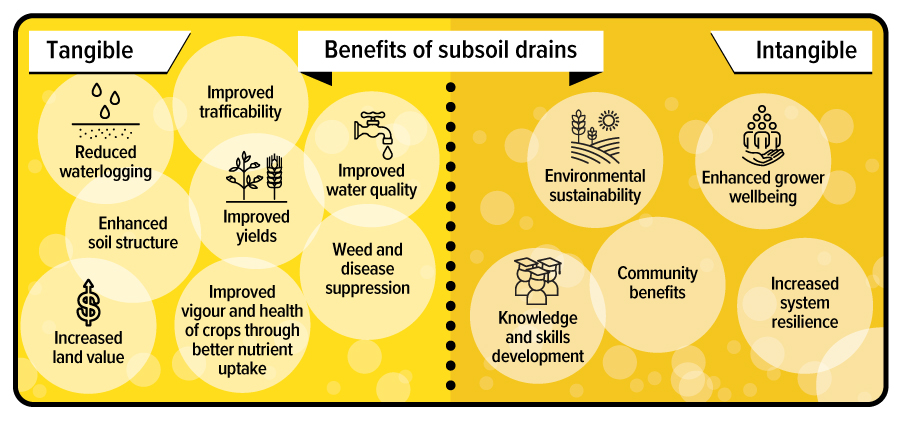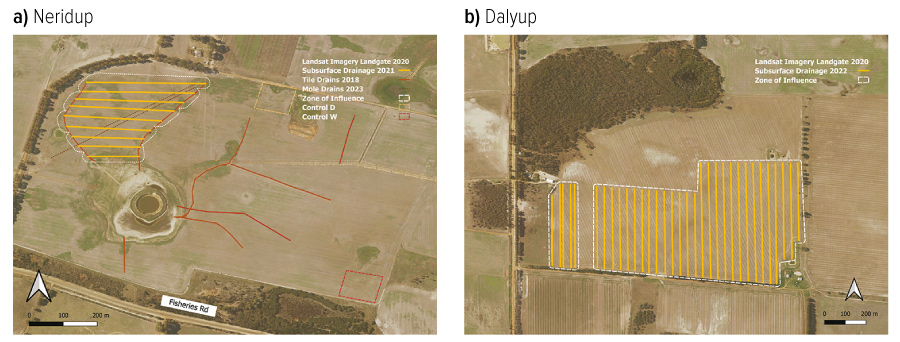Key points
- Return on investment can provide a meaningful metric to support adoption of a new management practice; for subsurface drains it was determined to be nine to 12 years
- The drains were expected to last at least 20 years with minimal repairs and maintenance, potentially extending beyond 30 years.
- Yield increases were achieved after the installation of subsurface drains despite experiencing seasons of one or three decile rainfall during the trial period
- Growers are recommended to seek expert advice when installing subsurface drains
In areas prone to waterlogging, subsurface drainage can pay off in under a decade, making it a profitable and effective management tool.
A GRDC-supported National Grower Network project has determined that the return on investment for installing subsurface drainage in southern Western Australian cropping areas prone to waterlogging is nine to 12 years.
The drains have been deemed a profitable and effective management tool to address waterlogging.
The project was managed by South Coast Natural Resource Management (NRM) and led by Sophie Willsher, who says the south coast of WA has about 3.6 million hectares that are moderately to highly susceptible to waterlogging with costly implications for crop health and farm profitability.
The grower-led ‘Subsurface drainage return on investment’ trial aimed to assist growers in making informed decisions around the efficacy of subsurface drainage to reduce the impacts of waterlogging on crop production and to increase farm profitability through increased yields,” Ms Willsher says.
The project was guided by a technical advisory group, which included local growers and hydrology and earthmoving specialists, together with researchers.
Subsurface drains offer numerous tangible and intangible benefits to growers. Tangibly they can enhance soil structure by preventing waterlogging, which in turn increases crop yield and reduces soil erosion. These soil structure improvements allow for more timely field operations and can extend the growing season. Intangibly, subsurface drains contribute to long-term sustainability and grower wellbeing. By reducing excess water, they improve soil health and can reduce crop diseases, ultimately leading to increased grower confidence and peace of mind (see Figure 1).
Figure 1: Tangible and intangible benefits of subsurface drains.

Source: GRDC
Additionally, the long-term preservation of soil quality ensures a farm’s viability for future generations, fostering a sense of stewardship and responsibility among farming communities.
“Further, if we can provide tangible financial figures for the bottom line and returns for installing a new innovation, it makes it a lot more meaningful for growers’ decision-making,” says Ms Willsher.
“As part of the project we engaged the services of an economist, Dr Elizabeth Petersen from Advance Choice Economics, to undertake a benefit–cost analysis of the subsurface drains to determine their cost-effectiveness and the timeframes associated with economic returns.”
About the drains
Ms Willsher recommends seeking advice and support from experts to install subsurface drains.
One of your most important factors to consider is the elevation of your paddock. It’s always best to work with gravity. You also should consider your soil profile and the depths to the clay layer, which is the impenetrable layer where most perched water will sit.
“Considering soil type and of course other factors on farm, including salinity levels, are important in making sure that your drainage is best designed for your property”.
Two subsurface drainage demonstration sites were established in the high-rainfall zones Esperance Port Zone at Neridup and Dalyup (Figure 2a and b and Table 1). Monitoring began in 2021 and collected data on perched water levels, yield improvements and environmental factors. The case studies illustrate how they need to be custom designed for each circumstance .
Figure 2: (a) Neridup subsurface drainage trial design; (b) Dalyup design.

Source: South Coast NRM and grower hosts
Table 1: Details of drainage systems installed at the Neridup and Dalyup sites.
Dalyup site | Neridup site | |
|---|---|---|
Host grower | Rohan Marold | Mic Fels |
Length of drains (km) | 19 | 2.6 |
Area of drains (ha) | 56 | 8.0 |
Area affected by drains (ha) | 66 | 9.2 |
Drain spacing (m) | 36 | |
Length to area ratio | Both sites have a drain length (km) to area (ha) ratio of 1:3 based on 36m spacings. | |
Depth of drains (m) | 0.6–0.8 (to depth of clay layer within the soil profile) | |
Installation | By landholder with equipment purchased from the US | By subsurface drainage contractor |
Design | A mesh sock was used to surround the drain pipes | Limestone aggregate was used to surround the drain pipes |
Cost of installation ($/ha) | 2990 | 5190 (higher cost due to aggregate cost and use of contractor) |
Source: South coast NRM and grower hosts
“The 2021 and 2022 harvests were record-breaking for the area, as a result of high rainfalls, and although Neridup and Dalyup both experienced significant waterlogging, the drains performed well and produced substantial yield benefits.”
Ms Willsher says the drains also presented yield benefits in 2023, despite experiencing seasons of one or three decile rainfall during the trial period.
The yield response due to the drains ranged from 1.13-1.49 tonnes per hectare for wheat, 1.36t/ha for barley and 0.07-0.72t/ha for canola.
Economics
The trial results suggest that subsurface drains are likely to be a cost-effective solution for managing waterlogged soils in the Esperance region of WA. This was supported by the financial analysis, which determined that the net present value of the trial drains ranged from $2000 to $2500 per hectare for the two sites, with a return on investment of 31 to 68 per cent.
The internal rate of return of the drainage systems was estimated at 12 to 16 per cent, which is well above current interest rates. The time to break even was estimated at 9 to 12 years, with the drains expected to last at least 20 years with minimal repairs and maintenance, potentially extending beyond 30 years.
More information: Johanna Tomlinson johannat@southcoastnrm.com.au

























































